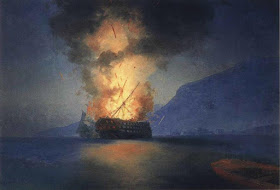The story of war against maritime trade in the Age of
Fighting Sail is usually told, whether in fact or in fiction, from the viewpoint
of the naval commerce-raider intent on prize-money. One finds few accounts which
view these contests from the side of the victims. I was therefore fascinated by
stumbling recently on an account of a furious battle between a civilian trader –
armed, as was essential at the time – and a French privateer in 1744, during the
War of Austrian Succession.
 |
| A trading brig by Joseph Walter,1838 - the Isabella may have looked generally similar. |
The Wrightson and Isabella of Sunderland was a merchant ship
engaged in trade across the North Sea and commanded by a Captain Richard Avery Hornsby
(1699-1751). No details are available of this vessel but given the fact that
she was manned by only five men and three boys, besides Hornsby, and that she
mounted four carriage guns – which could only have been small ones – and two
swivels, she cannot have been of large size, perhaps brig-rigged. On 13th
June 1744 Hornsby arrived off the Dutch coast at Scheveningen, the coastal
suburb of The Hague, in company with three smaller vessels with which he had
sailed in convoy from Norfolk. The Isabella
(it’s easier to refer to her as such) was laden with malt and barley. At this
period there was no harbour at Scheveningen – one would not be constructed
until 1904 – and trading vessels had to lie offshore and transfer cargoes
ashore in smaller boats. Fishing boats were drawn up on to the beach (a subject
for many painters, including Vincent van Gogh, for many years).
 |
| Fishing boats on the beach at Scheveningen, 1882 - by Vincent van Gogh |
 |
| View of Scheveningen 1871 by Johannes Joseph Destree Note the vessels clustered offshore - among such a grouping the Brancas would have lurked |
This part of the action lasted – amazingly – for upwards of
an hour but at two in the afternoon the privateer ran her bowsprit into the main
shrouds on Isabella’s port side and held
there. Captain André again demanded
that Hornsby strike, and was one again rejected. Some twenty French now crossed
only to be driven back by a hail of blunderbusses fire. The Brancas now broke free and attacked the Isabella on her starboard side. A new
boarding attempt was made – this must have been a nightmare conflict, conducted
as it was with hatchets and pole-axes as well as small arms. The two ships were
by now lashed together and Hornsby’s men, concentrated at the Isabella’s stern,
were somehow holding back the attackers, fresh men crossing from the Brancas to replace dead and wounded
boarders. These attackers had taken shelter behind (or rather ahead of) the
mainmast when Hornsby fired on them again with his blunderbuss. He had not
realised that in the heat of the moment it had been doubly loaded and, as he
fired, the weapon burst, throwing him down bruised but still defiant. Boarding
proving too costly, Captain André now pulled his men back on board the Brancas and broke away, apparently determined
on destruction – and revenge – rather than on capture of a prize.
 |
| A Royal Navy brigantine of the18th Century - the Brancas might have looked generally similar |
 |
| Boarding - the close-quarters horror of the Age of Fighting Sail |
 |
| A man-of-war exploding - by the Russian painter Ivan Aivazovsky The Brancas's detonation would have been smaller, but no less deadly |
The courage of Hornsby and his crew were deservedly recognised.
Three months later, at Kensington Palace, King George II presented him with a
gold medal and chain worth £100 while each of his crew members – who seem all
to have survived – were awarded £5 each, though with only £2 for the boys. It
is sad to note however that Hornsby lived only another seven years and died at
sea “of a lingering illness”.
He and his men deserve to be remembered.
Britannia’s Reach by Antoine Vanner
"Britannia’s reach is not just political or military alone. What higher interest can there be than consolidation of Britain’s commercial interests?” So says one of the key figures in this novel , which centres on the efforts of a British-owned company to reassert control of its cattle-raising investment in Paraguay, following a revolt by its workers. The story of desperate riverine combat brings historic naval fiction into the age of Fighting Steam. Click on the image below for more details.

Unbelievable courage and determination. You couldn't make it up.
ReplyDelete